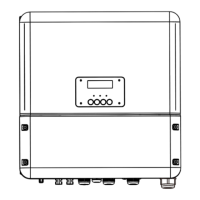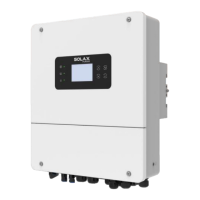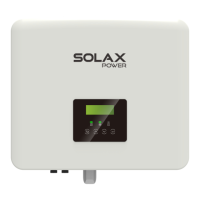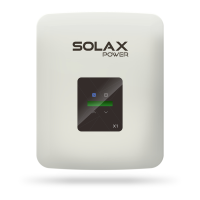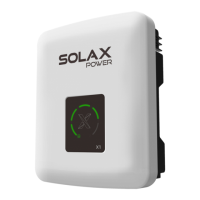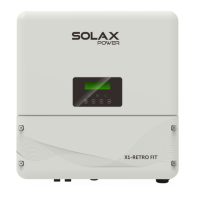3.3 Work Modes
Self Use
Feed-in priority
IntroductionIntroduction
①
②
③
①
②
③
16
17
The self-use mode is suitable for areas with low feed-in
subsidies and high electricity prices.
The power of PV will supply the loads rst, and surplus
power will charge the the battery, then remaining
power . will feed into the grid
The feed-in priority mode is suitable for areas with
high feed-in subsidies, but has feed-in power
limitation.
The power of PV will supply the loads rst, and surplus
power will d into , the fee the grid then remaining
power . will charge the battery
EPS (Off-grid)
Backup mode
①
②
①
②
③
The back-up mode is suitable for areas with
frequent power outages.
This mode will maintain the battery capacity at
a relatively high level, to ensure that the
emergency loads can be used when the grid is
off.
Same working logic with “Self-use” mode.
In case of power failure, the system will supply EPS
loads through PV and battery.
(The battery must be installed, and EPS loads shall
not exceed battery's max. output power.)
The power of PV will charge the loads rst, and
surplus charge the batterypower will .
Note:
The battery will stop discharging when SOC=min SOC. But due to
battery self consumption, sometimes SOC may min SOC.<
For on-grid status, if the battery SOC ≤ (min SOC-5%), the inverter will
take utility energy to charge battery SOC back to (min SOC+1%).
For off-grid status, if the battery SOC ≤min SOC, the inverter will be
unable to enter EPS mode (the battery will be unable to discharge)
unless SOC is back to 31%.
The self-use mode is suitable for areas with low feed-in subsidies and
high electricity prices.
Battery min SOC can be set:10%-100%
Charge battery to SOC can be set:10%-100%
The feed-in priority mode is suitable for areas with high feed-in
subsidies, but has feed-in power limitation.
Battery min SOC can be set:10%-100%
Charge battery to SOC can be set:10%-100%
The back-up mode is suitable for areas with frequent power outages.
This mode will maintain the battery capacity at a relatively high level,
to ensure that the emergency loads can be used when the grid is
off.
Battery min SOC can be set: 30%-100%.
Charge battery to SOC can be set: 30%-100%.
Description
Self Use
Feed-in
priority
Name
Backup
mode
In case of power failure, the system will power EPS loads through PV
and battery.
(Battery must be installed, and EPS loads shall not exceed battery's
max. output power.)
EPS(off-grid) SOC-min condition is adjustable within the range of
10%-25%.
EPS
(Off-grid)
6:00
18:00
12:00
24:00
has two settable working periods: The inverter
allowed discharging period and forced charging period.
For how to set the two working periods, please refer to page 92.
The default value of allowed discharging period is 00:00~23:59, and the
default value of forced charging period is 00:00~00:00 (closed in default).
You can set the two working periods by yourself.
As shown in the example above, the allowed discharging period is 6 am to
24 pm, and the forced charging period is 24 pm to 6 am.
Forced
charging
Allowed
discharging
• Forced charging period
The priority of forced charging period is higher than all work modes.
Under the forced charging period, the inverter will charge the battery rst
until the battery SOC reaches the value of "charge battery to".
• Allowed discharging period
Under the allowed discharging period, the inverter will allow the battery to
discharge (but not force the battery to discharge).
The following work modes will take effect under the allowed discharging
period.
For on-grid status, there are five work modes: Self Use, Feed-in Priority,
Backup, Manual and Peak shaving mode.
Priority: Loads > Battery > Grid
* For the above three work modes, when the power of PV is insufficient to
supply the loads, the battery will supply the loads. If the battery is insufficient,
then the grid will supply the loads.
Priority: Loads > Grid > Battery
Priority: Loads > Battery > Grid
Manual
This work mode is for the after-sales team to do after-sales maintenance.
Priority: Loads > Battery
For off-grid status, there is only one work mode: EPS (Off-grid).
Self Use
Feed-in priority
①
②
③
①
②
③
The self-use mode is suitable for areas with low feed-in
subsidies and high electricity prices.
PV will supply the loads rst, and surplus power will
charge the power the battery, then remaining will be
sold the grid to .
The feed-in priority mode is suitable for areas with
high feed-in subsidies, but has feed-in power
limitation.
PV will supply the loads rst, and surplus power will
be sold to the grid then remaining will , the power
charge the battery .
Priority: Loads > Battery > Grid
Priority: Loads > Grid > Battery
Backup mode
①
②
③
The back-up mode is suitable for areas with
frequent power outages.
This mode will maintain the battery capacity at
a relatively high level, to ensure that the
emergency loads can be used when the grid is
off.
Same working logic with “Self-use” mode.
* For the above three work modes, When the power of PV is insufficient to
supply the loads, the battery will supply the loads. If the battery is insufficient,
then the grid will supply the loads.
Priority: Loads > Battery > Grid
Manual
This work mode is for the after-sales team to do after-sales maintenance.

